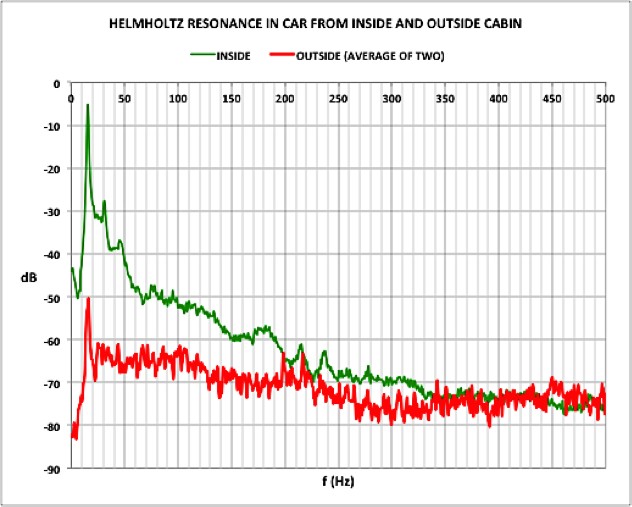The phenomenon of Helmholtz Resonance (HR) can be observed in various aspects of our daily lives, and surprisingly, inside your car as well. As a car expert at carparteu.com, I’ve explored numerous intricate systems within automobiles, and the car acting as a Helmholtz resonator is a fascinating example of physics in action. This article delves into an experiment showcasing this phenomenon, its implications, and what it means for your vehicle’s acoustics.
The Experiment: Detecting Helmholtz Resonance in a Car
In an interesting experiment, we aimed to detect and analyze Helmholtz Resonance within a car. The setup was quite simple: while driving at approximately 80 kilometers per hour (roughly 50 mph), we rolled down a rear window. This action created the necessary conditions for HR to occur within the car cabin.
The immediate effect was a noticeable and somewhat unpleasant buffeting sensation in our ears. This buffeting is the physical manifestation of low-frequency pressure variations, driven by the turbulent airstream rushing past the open window. To capture this resonance, we used recording equipment inside the car.
Following this, we took measurements from outside the vehicle. As my friend drove past multiple times with the resonance still active, I stood by the roadside and recorded the sound as the car passed. This allowed us to compare the resonant frequency both inside and outside the car.
Analyzing the Resonance Frequency
Upon analyzing the recorded audio from inside the car, a clear resonance frequency was identified at 15.5Hz. Remarkably, when we analyzed the recording taken from the roadside as the car drove by, the same 15.5Hz frequency signal was present. This was despite the fact that this specific frequency was inaudible to the human ear at that distance amidst the general car noise.
 Frequency analysis graph showing Helmholtz resonance at 15.5Hz inside and outside a car cabin, illustrating the resonator car part concept.
Frequency analysis graph showing Helmholtz resonance at 15.5Hz inside and outside a car cabin, illustrating the resonator car part concept.
Helmholtz resonance frequency analysis from inside and outside a car, highlighting the 15.5Hz peak.
The graph clearly illustrates a spike at 15.5Hz in both the inside and outside measurements, confirming the presence of Helmholtz Resonance. What’s striking is that from outside the car, this 15.5Hz spike was significantly stronger – approximately 15 to 20dB, or up to 100 times more intense – than the ambient background noise produced by the car’s engine and tires.
Unexpected Detectability of Car Resonator from a Distance
One of the most surprising findings was the considerable distance at which the Helmholtz Resonance was detectable outside the car. Initially, this led to an expectation that a similar phenomenon might be observed with a guitar soundhole. However, further investigation, as detailed in my other reports, revealed the opposite to be true in the case of guitars.
Understanding the Intensity of Car Helmholtz Resonance
The intensity of the Helmholtz Resonance in the car, compared to a guitar soundhole, likely stems from the driving force behind it. In a car, the turbulent airflow forcefully blowing across the open window provides a much more powerful impulse to excite the resonance. This contrasts with a guitar soundhole, where the driving impulse is generated by the instrument’s internal vibrations and sound production, which is proportionally less intense in terms of airflow.
While further research could definitively confirm this, it’s a plausible explanation for the observed difference in detectability and intensity of Helmholtz Resonance between a car cabin and a guitar soundhole.
Conclusion: The Car as a Resonator and its Acoustic Implications
This experiment effectively demonstrates that a car can indeed function as a Helmholtz resonator. The car cabin, with an open window acting as the ‘neck’ of the resonator and the cabin volume as the resonating chamber, amplifies specific low frequencies. This phenomenon is not just a matter of academic interest; understanding how your car acts as a resonator can be relevant in areas such as:
- Automotive acoustics design: Car manufacturers can consider Helmholtz Resonance when designing car bodies and ventilation systems to minimize unpleasant buffeting noises and optimize cabin acoustics.
- Noise reduction: Understanding resonance frequencies can help in developing better sound insulation and noise cancellation technologies for vehicles.
- Diagnostic applications: In certain scenarios, unusual resonance frequencies within a car might indicate issues with airflow or structural components.
While the experiment described here is a simple demonstration, it underscores the complex physics at play even in everyday experiences like driving a car. Recognizing the “Resonator Car Part” aspect of your vehicle can lead to a deeper appreciation of automotive engineering and acoustics.